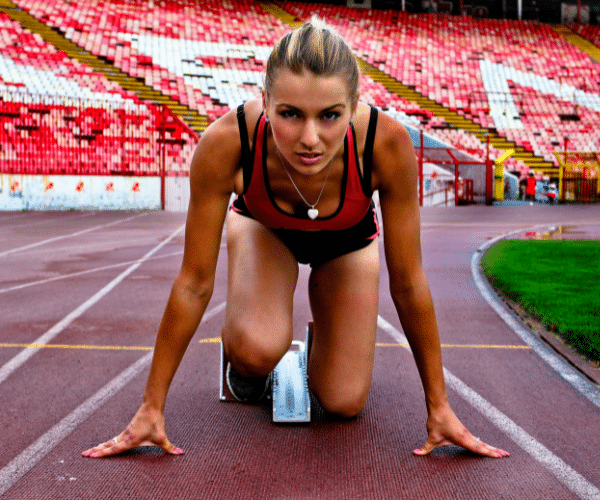May 9, 2024 7 min read

Risk Factors and Preventative Factors for Mental Well-Being and Sexual Respect in College Athletics
Industry:
Solution:

College athletes face many challenging situations during their college careers, and how best to support them will depend on their struggles. However, with the proper support in place, students can overcome these challenges and flourish.
Understanding the risk and protective factors can help the university determine the best way to support those students. Expert Jen Jacobson, executive director of health and wellness at Macalester College, partnered with Vector Solutions for a webinar discussing mental well-being and sexual respect among college athletes and shared the following insight about the risk and protective factors.
Risk Factors for Athlete Mental Health and Well-being
- Time demands and workload. The amount of time college athletes are required to spend on classes and at practices can cause stress. Students concerned about finances may experience more stress because they have less time to work.
- Pressure to succeed. The pressure to succeed athletically and the need to stay eligible, stay on track to graduate, and represent athletics and their team well in classrooms can cause stress.
- “Mental toughness” in sports. Athletics often has a culture of promoting mental toughness. This can be challenging because it can create a culture in which it is difficult for a student to admit they are struggling mentally. They may worry that if they disclose a mental health issue, it might cause their coach not to start them or believe they will be successful.
- Body image concerns. This includes a student’s concern about their appearance and how an injury might impact their body shape or composition.
- Injury. An injury can impact the student’s sense of identity as an athlete. Also, it might lead to isolation if their primary social group is other athletes, and they suddenly are unable to join their teammates at practice.
- Burnout. Students may feel obligated to keep going in a sport due to scholarship pressure or because it’s associated with their identity even though they no longer love it.
- Selection pressure. If there is an “A team” or starters, there will be additional pressure to be selected, which can be challenging and stressful for athletes, impact personal relationships, and lead to potential isolation from other students.
- Potential isolation from other students. While other first-year students are doing fun, social, or orientation activities, the athletes are practicing. “I’ve heard some of those fall sport athletes say, “everyone else got to make all of these friends during orientation, and I only met my teammates,” Jacobson says.
- Transition out of athletics. It can be challenging for college athletes who aren’t going to go into professional athletics after college to shift their mindset to whatever the next thing is for them.
Protective Factors for Mental Health and Well-being
Protective factors are characteristics associated with a lower likelihood of adverse outcomes or that reduce a risk factor’s impact. Providing an environment that promotes protective factors is a solid way to support prevention. Protective factors for college athletes include:
- Student-athlete community. Many students feel a sense of belonging and community by being on a team. Simple things like knowing there will always be a place in the dining hall where they can sit with teammates go a long way toward creating that sense of community.
- Close connection with a staff member(s). This can be a coach, an assistant coach, an athletic trainer, or someone else. Being an athlete comes with benefits in that these students are more likely to have someone who checks in with them regularly about their grades or checks on them if they miss practice for two days in a row and helps them find campus resources if they need them.
- Physical activity. This is universally important for all students, so it’s another area where being an athlete has significant benefits.
- Structure. Athletics provides structure in a student’s day, which can be helpful for many students, especially those new to campus.
- Time/identity away from academics. Athletics allows students to step away from their academics and do something else that is important to them. This is good for their well-being.
- Daily check-ins. When a staff or faculty member sees a student every day, issues can be caught before they become serious. Someone will likely notice sooner rather than later if something is not okay.
- Continuity of connection during breaks. A continuity of connection with teammates and coaches through social media, training programs, and other types of connections during breaks helps support a student’s well-being.
- Sense of belonging. Athletics offers students a sense of belonging both with their sports team and with their college or university as a whole.
- Motivation to avoid/limit substance use. Substance misuse can contribute to anxiety, depression, and more. College athletes report using less alcohol in-season than out-of-season and using less cannabis than non-athletes. Whether it’s due to team policies or other reasons, limiting substance use in general is supportive of mental health.
- Access to resources. College athletes often have more direct access to resources than others on campus. Career advisors or others come in specifically to talk to them. The athletic care center might refer them to the health center and resources off campus. They also often get the most training around Title IX.
Risk Factors for Sexual Aggression
- Alcohol misuse. Alcohol misuse, when combined with other risk factors, increases the risk of perpetrating an act of sexual aggression.
- Use of Sexually Objectifying Language. Studies have shown that young single men who frequently use sexually objectifying language to describe women while conversing with their male friends are more likely to engage in sexual aggression with a woman in that year. Therefore, if an athlete frequently uses such language, it may indicate that they are at a higher risk of becoming sexually aggressive.
Protective Factors for Supporting Sexual Respect
- High levels of empathy. In sports, when athletic leaders model empathy, it makes a difference.
- Feeling comfortable discussing women using equalitarian language. When males use language in conversations with male friends that emphasize females as equal, it reduces the likelihood of sexual aggression.
- Positive team norms. Having a positive environment and common goals among team members regarding what they want the team’s reputation to be and what they want the social experience for people to be when they interact with team members can help create a climate where sexual respect is the norm.
- Shared values. Having shared values around sexual respect can help promote a positive, supportive environment.
- Accountability. In athletics, the opinion of teammates and coaches has an impact. If a teammate says, “What you’re doing doesn’t represent your team well and doesn’t represent who we are,” it can make a difference. Teammates will often look out for each other to ensure their teammates are being responsible and respectful in social situations.
- Training. Athletes often get more training than others on campus on issues related to sexual respect.
- Strong leadership. In athletics, staff and student leaders model behaviors and everyone understands what the ground rules are. There are often close relationships with students and staff. Strong leadership around issues of sexual respect will help create a supportive culture around that issue.
- Socializing together. College athletes often go out together, so they are able to consistently practice some of the actions noted above.
Understanding risk factors and protective factors can help administrators create preventative programs to support athletes’ mental well-being and develop a culture of sexual respect.
Free On-Demand Webinar | Mental Health and Sexual Respect: Addressing Common Protective and Risk Factors for Student-Athletes
Watch our on-demand webinar on risk and protective factors to learn more about creating programs to support athletes' mental well-being and how to develop a culture of sexual respect at your institution.
Watch Now
How Vector Can Help
Vector Solutions provides higher education institutions with engaging, expert-authored online courses to support athletes and athletic staff. Courses provide training on important prevention, mental well-being, and safety topics with athletic-specific content designed to foster a supportive environment. Vector Solutions has also partnered with the U.S. Council of Athletes’ Health (USCAH) to offer training courses to help grow awareness of the importance of athletic safety, including mental health.
Courses include:
For College Athletes:
• Sexual Assault Prevention for Athletes
• Sexual Assault Prevention Ongoing: Athletes
• Mental Well-Being for Athletes
• Hazing Awareness and Prevention for Athletes
• And More!
For Athletic Staff:
• Sexual Assault Prevention for Athletic Liability
• Concussion Awareness: Athletics for Staff
• Title IX and Gender Equity in Athletics
• USCAH Athlete Safety Training Courses
• And More!
Learn more about our athletics offerings.







